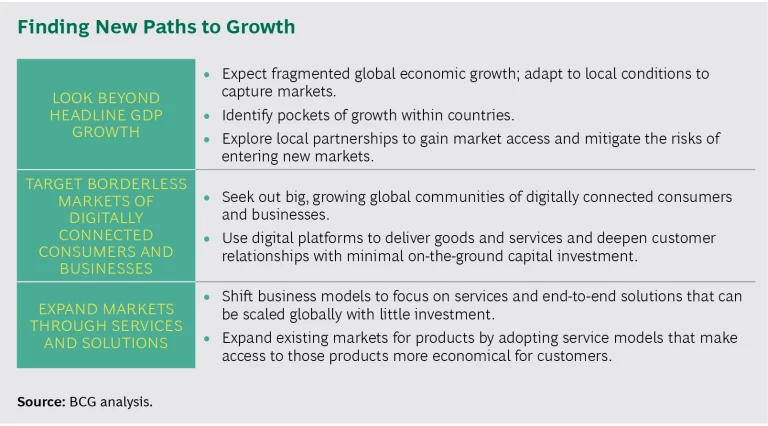This article is the second in a series exploring the profound changes in globalization and how to navigate this new world.
L ess than a decade after its launch, Airbnb has built an estimated $2 billion global hospitality business that operates in more than 190 countries and offers more than twice as many accommodation listings as the world’s biggest hotel chain—with no capital investment in properties. Fitbit, a US maker of wearable devices with a mobile app for monitoring fitness, retails in more than 65 countries and has boosted its revenue from around $5 million to $2.17 billion in only ten years, even though the company has fewer than 2,000 employees. Over a similar period, Uber has built a presence in 77 countries and generated more than $6 billion in revenue.
These companies have gained wide attention for transforming their industries with disruptive business models. But what makes these stories even more intriguing is their incongruity with the current narrative on the direction of the global economy. Geopolitical trends and macroeconomic data point to rising protectionism, stagnating trade and cross-border investment flows, and slowing global economic growth, leading many to proclaim globalization’s demise.
The success of companies like Airbnb, Fitbit, and Uber, however, suggests that globalization is alive and well. The world still abounds in opportunities for growth. But whether they are disruptive upstarts or established multinationals, companies must find new paths to growth markets—and they must often create those markets themselves. As the former chairman of a leading global consumer products company put it, “The question is no longer how much growth you can participate in. It’s how much you can shape.”
As we have written, globalization is being radically redefined by the rise of both economic nationalism and digital integration. While the world is becoming more decentralized politically and physically, customers, services, devices, processes, and businesses are interconnecting digitally. (See “ The New Globalization: Going Beyond the Rhetoric ,” BCG article, April 2017.) The winners in the years ahead will be the companies that adapt their products, approaches, and business models to the new global reality.
To succeed in this new era, companies must take a more nuanced approach to identifying and creating growth opportunities. They must navigate an increasingly fragmented global economy in which both the pace and drivers of growth in emerging markets are diverging. And they must adapt to a world in which businesses and the ecosystems in which they operate are being transformed by digital services and platforms.
This new environment presents companies with three overarching imperatives: (See the exhibit.)
- Look beyond GDP growth when assessing the attractiveness of countries.
- Target new borderless markets of connected consumers and businesses.
- Shift from product-based business models to value-added services and end-to-end solutions.
Look Beyond Headline Growth When Assessing Countries
In the previous era of globalization, determining when it was time to enter a particular market was relatively straightforward: you just kept an eye on the S curve, a measure that uses GDP per capita to determine when a market is ready for certain products. Emerging markets were seen as following similar growth trajectories as they were steadily homogenized by trade, investment flows, multinational corporations, and international rules. After building their presence in a few big takeoff economies, companies would replicate their success in other parts of the developing world as their per-capita GDPs rose. When annual household income in a country reached a certain level, that market was deemed ripe for products like washing machines, cars, and luxury goods.
Now, the rise of protectionism and government control of foreign investors are complicating global strategy. Companies can no longer assume that the global economy is governed by shared international rules or that all markets will evolve in the same way. As General Electric CEO Jeff Immelt stated in 2016, “In the face of a protectionist global environment, companies must navigate the world on their own.”
In the current global environment of fragmented growth and often-sudden policy and regulatory shifts, the old formula for prioritizing markets is obsolete. Companies need to get beyond top-line macroeconomic statistics. Opportunities can be found even in economies with low GDP growth.
Consider Brazil. After a decade in which annual GDP growth averaged around 5%, Brazil’s economy stalled in 2013 and then slid into recession as a result of falling commodity prices and a budget crisis. Personal consumption contracted by 2.6% in 2015 and by 2.8% in 2016. But Brazil still has the world’s fifth-largest population and millions of middle-class and affluent households living in interior cities that many modern retail segments, such as pharmacy, have not yet reached. Despite the harsh macroeconomic environment, retail pharmacy outlets registered a CAGR of 15.5% from 2013 through 2015, when that of other retail segments, such as apparel, consumer electronics, and department store sales, slowed to 2% to 3%. Retail pharmacy players from the US, recognizing the surging consumer demand in Brazil’s highly fragmented market, seized the opportunity to fuel their international growth.
China is another case in point. The slowdown in GDP growth from around 10% a year in the 1990s and the first decade of the 2000s to around 7% has been interpreted by many as a sign of economic trouble. Still, personal consumption has been growing by 8.4% annually since 2010. By 2020, the country is forecast to have nearly 550 million households with annual incomes of at least $10,000. Starbucks is one of the many companies that have capitalized on this growing affluence as well as on increasing urbanization. Since 2011, Starbucks has expanded the number of stores in China roughly fivefold, to 2,400; around half of those outlets are company owned.
Just as GDP statistics don’t fully capture opportunities, they may not accurately reflect the challenges of entering a particular market. Even high-growth markets can be difficult to penetrate, for example, because of intense domestic competition or difficult regulatory environments. Innovative partnerships with local players can help companies surmount those obstacles. A global supplier to the mining industry, for example, found that its profit margins on products were shrinking in an important market because of competition from low-cost producers. Instead of withdrawing from the country, the company developed a new service business. It partnered with local suppliers to offer low-cost (commodity) products while drawing on its extensive global expertise to provide turnkey services to clients. The package of products and services enabled the company to compete successfully in this key market.
Just as GDP statistics don’t fully capture opportunities, they may not accurately reflect the challenges of entering a particular market.
Partners can make it easier to expand rapidly in a growth market that is prone to regulatory shifts and other kinds of risks. Recent strategic moves by several major international fast-food chains in China offer an example. The chains had become targets of anti-US protests and increased regulatory pressure. In response, the chains sold majority stakes in their China operations to domestic partners and shifted to a model in which stores are owned by franchisees rather than the parent company. Because its franchisees can take advantage of local know-how, one of the chains has been able to open many more stores—especially in smaller cities—and has adapted its menus to local tastes.
Target Borderless, Digitally Connected Markets
Connectivity is soaring: globally, the number of internet users is approaching 4 billion, while the number of connected smartphones and tablets has grown more than 13-fold, to 3.6 billion, just since 2009.
While the rapid increase in connectivity helps companies reach markets around the world, it also contributes to the creation of a new kind of market—one that transcends national boundaries. Consumers (many of whom have smartphones) are more physically mobile than ever before, breaking down the notion of geographic segmentation, and digital platforms let companies serve them, wherever they are, with minimal investment.
One huge borderless community consists of tourists, who represent a $1.2 trillion global market. Airbnb has been so successful in tapping this segment that its market valuation of $30 billion surpasses that of any of the world’s biggest hotel chains. China’s Alipay is also building a global business by providing services to digitally connected tourists. Alipay offers a mobile payment platform that has 450 million active subscribers, who use it as an alternative to credit cards. The company has been targeting the fast-growing market of Chinese travelers, who are projected to spend $1.75 trillion by 2030, compared with $500 billion in 2012. To reach this market, Alipay has partnered with global payment providers such as Verifone and First Data. Luxury department stores, retailers, and such global brands as Body Shop accept Alipay, as does Uber.
Fitbit has used a digital platform to reach a different global borderless market—health-minded individuals. To establish its presence in dozens of countries, Fitbit customized its smartphone app for multiple languages while setting up a fulfillment and customer support network across the globe.
Pokémon GO developer and publisher Niantic and The Pokémon Company captured the digitally connected global community of mobile gamers. One month after the augmented reality mobile game for Android and iOS devices was released, in July 2016, Pokémon GO topped the mobile download charts in 70 countries. Within six months, it was being played in more than 150 countries and had generated almost $1 billion in revenue through app purchases and online advertising.
Borderless markets aren’t just about consumers. Caterpillar offers Cat Connect, a range of digital services that help the company’s business customers boost the productivity and efficiency of their construction equipment, no matter where that equipment is located. By remotely accessing and analyzing real-time data on individual pieces of equipment, Cat Connect can help customers monitor and manage the cargo loads and routes of their fleets, benchmark equipment performance, and optimize preventive maintenance schedules. General Electric uses its digital platform to build its business-to-business market. The company has invested in its industrial internet platform, Predix, which provides a cloud-based central data analytics ecosystem that reaches digitally connected equipment around the world.
Expand Markets Through Services and Solutions
In the new era of globalization, rising trade barriers and limited financial resources may hinder companies’ ability to achieve growth by relying primarily on sales of physical products. But services offer different opportunities. “Servitization” is emerging as an increasingly important way to create new avenues of growth in an existing market for products. Manufacturers are discovering that they can create value for their customers by delivering digital services and end-to-end solutions to connected consumers and businesses. “Servitization provides new opportunities for global growth even in low-growth markets,” noted the chief strategy officer of a leading industrial goods company. “In fact,” he said, “our service businesses are growing faster than our hardware businesses because of the possibility for greater value addition.”
Whirlpool illustrates the blurring lines between product and service businesses. As kitchen appliances become digital devices that are seamlessly integrated into connected homes, Whirlpool notes that these products will be defined by both physical and digital experiences. As part of its strategy, Whirlpool recently acquired Yummly, a leading digital platform for personalized recipes and cooking resources, to provide value-added services that can streamline the cooking and meal-planning experience of its customers.
By offering services, global companies can also enter markets that would otherwise not be viable, either because their physical products are too expensive for potential customers or because demand is too low to justify the heavy capital investments required to manufacture locally. Through a service model, companies can sell access to products rather than the physical products themselves, an arrangement that is much more affordable for consumers.
Through a service model, companies can sell access to products rather than the physical products themselves.
Digital technology allows companies to deliver services at low cost because they can be scaled up more economically and quickly than manufactured goods. Furthermore, companies can leverage local partners to deliver services, making it more economical to target smaller market segments across many countries.
A leading manufacturer of computed tomography (CT) systems illustrates how manufacturers can greatly expand their global markets by offering services. The company’s CT scanners cost anywhere from hundreds of thousands to several million dollars, well beyond the budgets of many hospitals and clinics in developing economies—especially countries that assess high import duties.
Under its traditional business model, the company sells a CT scanner to a hospital and trains the hospital’s technicians to operate the equipment. Now, the company is exploring a model in which it would provide the equipment and the technicians to operate it, and the hospital would pay on a per-scan basis. In the future, the company could consider a full-service model that would include remote diagnosis over digital platforms using a global network of experts and doctors. This would free up a hospital’s medical professionals to focus on delivering care to patients.
The viability of such a full-service model requires overcoming logistic and regulatory hurdles, especially regarding data privacy and health information. And it relies on specialization and the ability to leverage connectivity and data analytics. Bringing together information—in this case, scans—from all over the world would allow centralized teams of expert radiologists and physicians to diagnose results more accurately than a hospital’s physician, who may see only a few cases each day. A global team could be located in any part of the world where it can utilize the company’s capabilities in analytics and data management.
Auto manufacturers are also branching out into services that target drivers who prefer the lower cost and greater convenience of paying to use products rather than owning and maintaining them. Daimler has launched a car-sharing service called car2go, for example. The service’s fleet of around 14,000 vehicles is being used by more than 2 million registered customers in 30 locations in North America, Europe, and China. Drivers book cars through smartphone apps or over the internet and pay by the minute. BMW offers a similar car-sharing service called DriveNow in Australia and 14 European countries in a partnership with the car rental company Sixt.
Identifying the next growth opportunities may no longer be as straightforward as it once seemed. But even as political trends, economic expectations, and digital integration continue to redefine globalization as we have long known it, the world still offers many new opportunities and new markets—for companies that learn how to find or create those opportunities and develop innovative business models to capture them.
Companies that are able to navigate the fundamental shifts underway in the global economy and adapt their product offerings and business models accordingly can seize formidable competitive advantages.
The BCG Henderson Institute is Boston Consulting Group’s strategy think tank, dedicated to exploring and developing valuable new insights from business, technology, and science by embracing the powerful technology of ideas. The Institute engages leaders in provocative discussion and experimentation to expand the boundaries of business theory and practice and to translate innovative ideas from within and beyond business. For more ideas and inspiration from the Institute, please visit
Featured Insights
.












